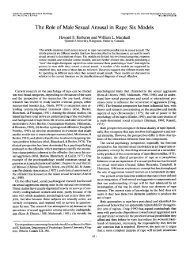Regulation of the dopamine transporter - Addiction Research ...
Regulation of the dopamine transporter - Addiction Research ...
Regulation of the dopamine transporter - Addiction Research ...
Create successful ePaper yourself
Turn your PDF publications into a flip-book with our unique Google optimized e-Paper software.
DAT <strong>Regulation</strong> Schmitt & Reith<br />
by <strong>dopamine</strong>rgic neurons can affect <strong>the</strong> DAT. Of <strong>the</strong><br />
possible GPCR subtypes that can affect DAT function,<br />
<strong>dopamine</strong> D2-like autoreceptors are <strong>the</strong> most<br />
logical candidates, with <strong>the</strong>ir presynaptic localization<br />
and clearly defined role in regulatory inhibition<br />
<strong>of</strong> both tyrosine hydroxylase 92 and vesicular<br />
<strong>dopamine</strong> release. 93 However, although D2-like autoreceptors<br />
are <strong>the</strong> most thoroughly investigated,<br />
o<strong>the</strong>r GPCRs also appear to modulate <strong>dopamine</strong>rgic<br />
neurotransmission by altering DAT function.<br />
In particular, activation <strong>of</strong> both �-opioid receptors<br />
and TAAR1 receptors (a member <strong>of</strong> a recently discovered<br />
family <strong>of</strong> receptors for endogenous trace<br />
amines) has been shown to elicit changes in DAT<br />
function.<br />
Dopamine D2 and D3 autoreceptors<br />
The D2-like family <strong>of</strong> <strong>dopamine</strong> receptors comprises<br />
D2,D3,andD4 receptor subtypes. In addition<br />
to <strong>the</strong>ir role as classical postsynaptic receptors, <strong>the</strong><br />
D2 and D3 subtypes are expressed by <strong>dopamine</strong>rgic<br />
neurons <strong>the</strong>mselves, serving as presynaptic autoreceptors.<br />
Activation <strong>of</strong> D2-like autoreceptors attenuates<br />
<strong>dopamine</strong>rgic neurotransmission via several<br />
parallel mechanisms: in PC12 cells, for example,<br />
treatment with <strong>the</strong> D2/D3 agonist quinpirole causes<br />
feedback inhibition <strong>of</strong> tyrosine hydroxylase—<strong>the</strong><br />
rate-determining enzyme in <strong>dopamine</strong> syn<strong>the</strong>sis—<br />
and decreases K + -evoked <strong>dopamine</strong> release. 93 In<br />
addition to reducing stimulated <strong>dopamine</strong> release,<br />
recent evidence suggests that D2 and D3 receptor<br />
activation also reduces extracellular <strong>dopamine</strong> concentration<br />
via acute upregulation <strong>of</strong> DAT function.<br />
This effect was first demonstrated in <strong>the</strong> early 1990s<br />
by using rotating disk electrode voltammetry to<br />
measure <strong>the</strong> rate <strong>of</strong> extracellular <strong>dopamine</strong> clearance.<br />
That is, Meiergerd et al. demonstrated 94 that<br />
<strong>the</strong> D2/D3 agonist quinpirole increases <strong>the</strong> V max <strong>of</strong><br />
<strong>dopamine</strong> transport into rat striatal synaptosomes,<br />
an effect that is reversed by concomitant administration<br />
<strong>of</strong> <strong>the</strong> antagonist sulpiride. The authors also<br />
showed in vivo evidence <strong>of</strong> <strong>the</strong> inverse situation: a<br />
reductionin<strong>the</strong>V max <strong>of</strong> <strong>dopamine</strong> clearance in rats<br />
chronically treated with <strong>the</strong> potent D2 antagonist<br />
haloperidol. In support <strong>of</strong> this finding, localized intrastriatal<br />
application <strong>of</strong> <strong>the</strong> selective D2 antagonist<br />
raclopride has also been shown to decrease clearance<br />
<strong>of</strong> exogenous <strong>dopamine</strong> applied locally via a<br />
second micropipette. 95 Studies using selective D3<br />
receptor ligands paint a similar picture: <strong>the</strong> selective<br />
D3 agonist PD128907 increases electrochemically<br />
measured <strong>dopamine</strong> clearance in rat nucleus accumbens<br />
slices, producing an increase in transport V max<br />
with no effect on <strong>the</strong> K m <strong>of</strong> <strong>dopamine</strong> after a 10min<br />
preincubation. 96 In contrast, <strong>the</strong> D3 receptor<br />
antagonist GR103691 decreased <strong>dopamine</strong> significantly<br />
below vehicle levels. In Xenopus oocytes coexpressing<br />
hDAT and D2R transcripts, activation <strong>of</strong><br />
D2 receptors with apomorphine for as little as 5 min<br />
results in a 40% increase <strong>of</strong> whole-cell [ 3 H]CFT<br />
binding (Bmax) with no alteration in <strong>the</strong> Ki value<br />
for CFT, suggesting that activation <strong>of</strong> D2 receptors<br />
triggers rapid trafficking <strong>of</strong> intracellular DATs to <strong>the</strong><br />
plasma membrane. 97 Upregulation <strong>of</strong> surface DAT<br />
expression by D2 receptor agonists requires Gi/Go<br />
protein coupling, because pretreatment with pertussis<br />
toxin (PTX) blocked <strong>the</strong> increase in [ 3 H]CFT<br />
binding. In our collaborative study with <strong>the</strong> group<br />
<strong>of</strong> Garris, in vivo voltammetry was used to monitor<br />
<strong>dopamine</strong> uptake and release in rat striatum<br />
and nucleus accumbens. 98 We found that D2R antagonism<br />
reduced uptake at all frequencies used to<br />
stimulate <strong>the</strong> medial forebrain bundle, whereas release<br />
was enhanced only at lower frequencies. Be<br />
that as it may, both processes—D2R regulation <strong>of</strong><br />
<strong>dopamine</strong> uptake as well as release—serve as parallel<br />
feedback mechanisms aimed at reducing extracellular<br />
<strong>dopamine</strong> levels when high <strong>dopamine</strong> levels<br />
activate D2 receptors.<br />
Most investigations into <strong>the</strong> effects <strong>of</strong> D2-like receptor<br />
ligands on DAT function in vitro have used<br />
electrochemical methods to assess <strong>dopamine</strong> uptake<br />
in animal tissues, in lieu <strong>of</strong> more commonly<br />
used measurement <strong>of</strong> [ 3 H]<strong>dopamine</strong> uptake by heterologous<br />
cells. The reason for this methodological<br />
preference is purely technical: <strong>dopamine</strong> is a<br />
high-affinity agonist at D2 and D3 receptors, creating<br />
an obvious confound because <strong>the</strong> radioligand<br />
will activate <strong>the</strong> receptors as well. Although electrochemical<br />
detection has greater temporal resolution<br />
than is possible with cell models, 16 it does not allow<br />
direct observation <strong>of</strong> effects on DAT trafficking<br />
in concert with kinetic measures <strong>of</strong> DAT function.<br />
Recent studies have overcome this issue by using a<br />
novel syn<strong>the</strong>tic DAT substrate that is easily detected<br />
yet exhibits negligible affinity for <strong>dopamine</strong> receptors.<br />
The substrate 4-(4-(dimethylamino)styryl)-<br />
N-methylpyridinium (ASP + )—a styryl analogue<br />
<strong>of</strong> <strong>the</strong> neurotoxic substrate MPP + —has <strong>the</strong> added<br />
benefit <strong>of</strong> possessing a fluorescent �-conjugated<br />
326 Ann. N.Y. Acad. Sci. 1187 (2010) 316–340 c○ 2010 New York Academy <strong>of</strong> Sciences.










